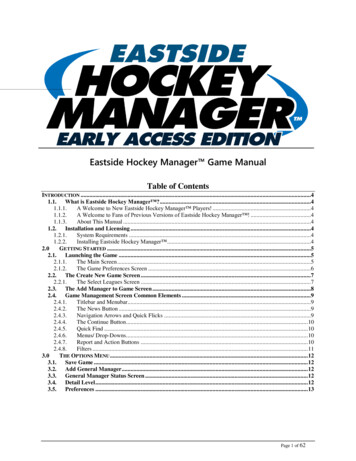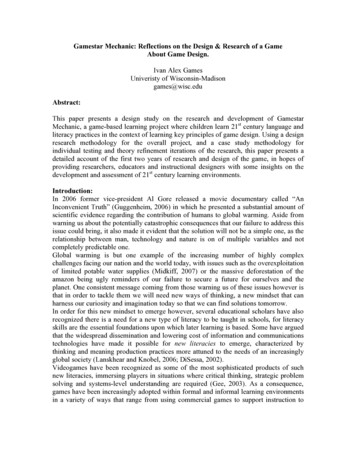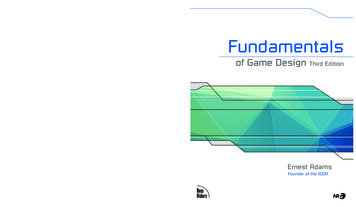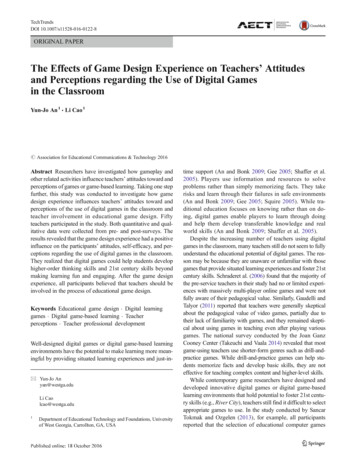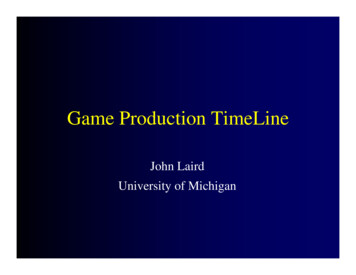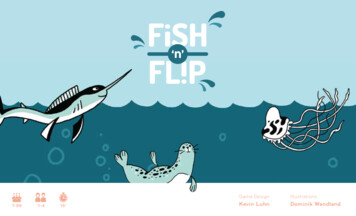
Transcription
7-991-415‘Game DesignIllustrationsKevin LuhnDominik Wendland
ComponentsSetup120 cards, which are79 marine animal cards (10 whale,swordfish, octopus, turtle, dolphin, jellyfishand ray cards, and 9 shark cards)1 boat card20 action cards12 waste cards (6 plastic, 3 metal, 3 oil)8 power cards (1 for each animal)Players will only be using 4 marine animals per game.If you’d like to use more animals at the same time,feel free to try the campaign mode (available on ourwebsite).Goal of the gameVarious animals have been caught in fishing nets:players will have to work together and programtheir actions in order to free them. To achieve thebest combos, you’ll have to cleverly combine thepowers of your animals. But be careful in dealingwith waste! The more nets you manage to emptyby the end of the game, the more points you’llscore.First, choose 4 marine animals to play with and setaside their corresponding animal cards and powercards. Return the remaining animal cards and powercards to the box: they will not be used in this game.Shuffle the chosen animal cards together with anumber of waste cards, depending on your preferreddifficulty level: 4 waste cards for a normal game, and 6for a difficult game.Note: be sure to flip the cards a few times whileshuffling, so that the animals aren’t all facing the sameway.
Setup examplePrepare the fishing net by placing down 3 rows of 4cards. Create a draw pile with the remaining cards andplace it next to the play area. Place the boat card at thelevel of the seventh row.Shuffle the action cards and deal 2 cards face upto each player (3 cards in a 2-player game). Createa draw pile with the remaining cards and place itnext to the play area. Finally, each player draws onepower card: this will be their power for the rest ofthe game.The last player to spot a dolphin starts the game.Note: cards must always be placed down in such a waythat their bubbles are in the top right corner.
Turn overviewPlayers take turns playing in clockwise order. You’reallowed (we even recommend this) to consult eachother in order to come up with the best strategy.Your turn consists of 4 steps:1. M oving animalsOn your turn, use one of your action cardsto form groups of animals (the action cardswill be explained in detail later). Thendiscard the card and draw a new one.Note: You may use your animal’s power once perturn, if you want to. The powers will be explainedin detail later.2. Freeing animalsYou may free all groups consisting of at least2 adjacent animals of the same type that areswimming in the same direction.Note: at least one of the cards in the grouphas to have moved during step 1 in order tofree the animals.Remove the animal cards from the play area andplace them in a discard pile.
3. Lowering animalsLower the remaining animal cards towards thebottom of the net.4. Refilling the netsStarting from the left, add one new card tothe top of each column. If new groups ofanimals are formed during this step, theyare not freed.Note: If new groups of animals are formed afterstep 3, perform steps 2 and 3 again. Whenyou’re no longer able to free any animals,continue to step 4.Note: When you’re forced to add a seventh card toa column, you immediately lose the game!Now, the player to your left takes their turn.If you managed to free 5 animals (or more) in asingle turn, shout “Fish’n’Flip!”
End of the gameWhen the final card is added to the play area andthe draw pile of animal cards is empty, the end ofthe game is triggered. The two next players in turnorder each get one final action to try and free asmany animals as possible. After that, the game isover.Note: Depending on the number of waste cardsand the chosen animals, it could happen that thereare less than 4 cards to add when the end of thegame is triggered. In that case, add the remainingcards and finish the game as normal.Count the number of animals that are still caughtin the nets: the lower the number, the better yourscore will be! Would you like to know how youdid? Go and find out on our website!
Animal cardsThere are 8 different types of animals and 10 cardsper animal, except the shark (which only has 9).Each card shows the same type of animal andthe same type of background on the front andback. However, the direction in which it swimsis different, depending on the side of the card:flipping an animal allows it to change direction.Each animal also has a background color: there are4 differently colored backgrounds.
Power cardsDolphinEach animal has a power that can be used onceper turn. Using powers is always optional.When you flip a dolphin card, youmay also flip an adjacent card.There are 2 types of powers:OctopusMovement powers, which are activatedduring the ‘Moving animals’ step (1).When you flip an octopus card, youmay also flip a card of the samebackground color.Evasive powers, which are activatedduring the ‘Freeing animals’ step (2).RayWhen you free a group of rays,you may also free other rays in thesame rows and/or columns that areswimming in the same direction.Advanced variant: rays can formgroups at a distance, and use theirpower even though they’re notadjacent.
SwordfishTurtleWhen you free a group of swordfish,you may also free an adjacent animalcard or waste card. Freed waste cardsare placed underneath the draw pile.Exception: if you free a swordfishdirectly using the correspondingaction card, you may use its powereven if it’s by itself.WhaleWhen you flip a whale card, placethe card at the bottom of its column,below any other cards that might stillbe there.SharkWhen you flip a shark card, you mayfree it, even if it’s by itself.After you flip a turtle card, move ithorizontally one space in the directionit’s swimming in. If the space is empty,the card simply moves and nothingelse happens. If the space is occupiedby another card, the two cards switchplaces.JellyfishAfter you flip a jellyfish card, move itvertically one space in the directionit’s swimming in. The jellyfish switchesplaces with the adjacent card.
Waste cardsMetalThere are 3 different types of waste. Waste cardsdo not form groups, but they can be flipped overor switched with other cards.This type of waste is too heavy tomove around using the action cards.You may only use an action cardif there’s no metal waste involved.However, metal waste can be movedusing the powers of the turtle or thejellyfish.PlasticThis type of waste is foundeverywhere in the ocean and it alwaysseems to find its way back. The powerof the swordfish allows you to removethem from the net, but be careful:waste cards are not discarded. Placethem underneath the draw pile.OilAny marine animals orthogonallyadjacent to this type of waste lose theirpower. This means oil can’t be removedusing a swordfish.These last two types of waste are only used inthe campaign mode.
Action cardsThere are 2 types of actions: switchingcards and flipping cards.Flip all cards with the same background color.Flip a card.Switch two orthogonally adjacentcards (without flipping them over).Flip an entire column of cards.Switch and flip two orthogonallyadjacent cards.Flip an entire row of cards.Free an animal.Flip a square group of cards (asquare group may consist of fourcards, or of three cards and anempty space).
Competitive versionIn this variant, players have to fend for themselves:they take their turns simultaneously, trying to findthe optimal combination and freeing as manyanimals as possible. The player who manages tofree the most animals wins the game!REQUINDAUPHINHAIDELFINSHARKDOLPHINSetupTurn overviewJust like in the cooperative version, choose 4marine animals and their corresponding powercards. Return the remaining cards to the box. Fromthese 4 powers, choose 2: these powers will becommon and accessible to all players.Everyone plays simultaneously. Look at the playarea and the available action cards, then bet onthe number of animals you’re going to save usingone of the 2 action cards and the available powers.Once someone calls out a number, the otherplayers have one minute to raise the bid. Whenthe time is up, the player with the highest bid maycarry out their action.Note: in this version, the animal powers may becombined and/or used several times per turn, butonly once per card.Shuffle the animal cards and reveal the top 9cards. Place them in a 3x3 grid. Shuffle the actioncards and reveal the top 2 cards.
Did you manage to free. The exact number of animals you bid?Place the freed animal cards in front of you. Fewer animals than the number you bid?Take a waste card and place the freedanimals on the discard pile: you don’treceive anything else this turn. More animals than the number you bid?Distribute the excess cards among youropponents (you may choose how todistribute them).Place the remaining animal cards on the discardpile and draw 9 new cards to start the next roundof bidding.Also discard the action cards and reveal two newones.If the draw pile contains fewer than 9 cards, shufflethe discard pile to create a new draw pile.End of the gameThe game ends when the draw pile is emptiedfor the second time and it’s no longer possible tocreate a new grid of 9 cards.Calculate your points: each animal card is worth1 point, and each waste card is worth 2 negativepoints. The player with the highest score wins thegame.Dominic announces he’s planning to free 6 animals. Heflips the dolphin card in the middle and creates a groupof 3 dolphins. He also uses the dolphin’s power to flipand free the shark to its left, thereby creating a groupof 2 swordfish on the left, which are also freed. Hemanaged to free 6 animals and wins the bid.Looking for a bigger challenge?Try the campaign mode and go through all themissions together!
Marine pollutionThe world’s oceans are polluted: according toestimates, between 4.8 and 12.7 million tonnesof plastic waste are dumped into the ocean eachyear.Fishing boats are among the biggest polluters.It often happens that fishermen lose their netswhile they’re out at sea, or that they throw themoverboard when they’re damaged instead ofdisposing of them properly. This poses a threat towhales, dolphins and other marine mammals thatsuffer a horrible death after they get entangled.Around 640,000 tonnes of fishing nets andother materials are dumped into the ocean eachyear, causing the death of around 136,000 seals,dolphins, sea lions, turtles, small whales andseabirds.Bycatch also causes problems for our oceans.Numerous animals that get caught were notintentionally targeted by the fishermen, which meansthey are often pulled from the ocean without beingused. For example, 250,000 sea turtles, 300,000whales and dolphins, and several millions of sharksand rays end up in fishing nets each year.English Translation: Jo Lefebure for The Geeky Pen
Here‘s how you can help on a smaller scale: Collect waste on the beaches:you can participate in theInternational Coastal Cleanup(ICC) in your country. Thisinitiative is organized by OceanConservancy all over the world,and takes place annually duringthe third week of September.Please join in! Only purchase fish that wascaught durably: the MSC labelissued by the Marine StewardshipCouncil guarantees that thefishing activities are monitored inorder to maintain the structure,productivity, function and diversityof the ecosystem. Associationslike the WWF have also publishedconsumer guides which you canfind on their websites. Don’t forget anything! When yougo to the beach, remember to takeback everything you brought withyou. Don‘t leave behind any food,toys, cigarette butts or other typesof waste. Everything will eventuallyfly off and end up in the sea. Youcan also gather waste that doesn’tbelong to you and throw it in agarbage can. If you want to do even more, youcan join associations that worktirelessly to protect the fauna andmarine life. Sea Shepherd, SanaMare and others have branchesall across the globe, so pleaselook them up!
helvetiq.comHelvetiq is a Swiss publishing house that was founded in 2008 afterthe launch of their first game, which carries the same name. Since then,they’ve been publishing board games but also beautifully designedbooks for the entire family. Each title is treated with passion and offers anew way of viewing the world - and of sharing it with your loved ones.Gaiagames is a highly motivated, durable gaming collective that knowslittle hierarchy. With the help of their ecological games, they aim toinspire and sensitize people to important subjects (nature, environment,politics, .). Because the best way to learn is by having fun!gaiagames.dein collaboration withsalamandre.orgFounded in 1983 out of a child’s passion, Salamandre has grown tobecome an independent, non-profit French/Swiss publishing house.It helps you to discover the beauty of authentic nature by means ofreviews, books and movies, while adhering to an exceptionalenvironmentally conscious approach and strict quality standards.
7-99 1-4 15' Dominik Wendland. Components 120 cards, which are 79 marine animal cards (10 whale, swordfish, octopus, turtle, dolphin, jellyfish and ray cards, and 9 shark cards) 1 boat card 20 action cards 12 waste cards (6 plastic, 3 metal, 3 oil) 8 power cards (1 for each animal)
